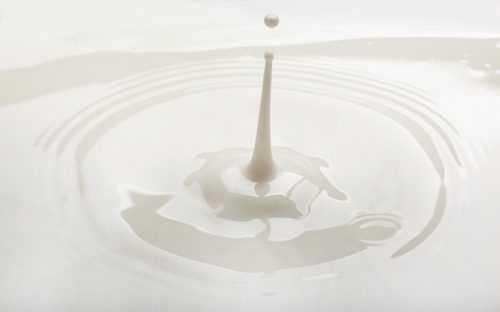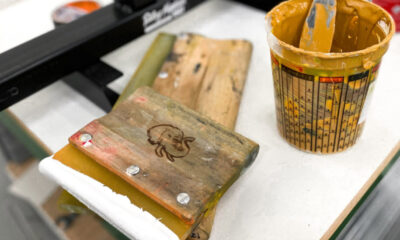Garment Printing
Published
14 years agoon

All garment screen printers want magic in a can—a white ink that always works perfectly on every type of apparel. Unfortunately, this mystical product does not exist. No ink formulation contains every desirable performance characteristic. That means garment screen printers must make concessions and plan carefully.
All garment screen printers want magic in a can—a white ink that always works perfectly on every type of apparel. Unfortunately, this mystical product does not exist. No ink formulation contains every desirable performance characteristic. That means garment screen printers must make concessions and plan carefully.
Small and medium shops usually get by with a couple of white inks. They focus on the types of fabrics on which they print most often and keep the appropriate inks on hand. Repetition alone enables these printers to master the use of a few white inks quickly. However, production managers in larger operations face the challenge of selecting specialty white inks for more challenging fabrics, such as polyesters and high-elongation materials.
I recently encountered some interesting strategies at two large garment-printing facilities. The first kept three or four different white inks on hand but printed 100%-cotton garments exclusively. Having more white formulations in house than necessary causes confusion. The other shop standardized to one white ink—a bleed-resistant formulation—that usually works across the board. Most of this shop’s work is on 100% cotton, which makes a bleed-resistant white an odd choice.
Almost any high-opacity white formulated for cotton would suffice. A bleed-resistant is only required for the occasional 50/50 blend making its way through the facility. This company rarely prints on 50/50 apparel but uses a bleed-resistant white because the production manager favors its opacity and flashing characteristics. However, the ghosting issues that arise after the goods are shipped might convince the manager to look at other inks.
The search for an all-in-one white ink is a waste of time, and stockpiling lots of different white inks is a waste of resources. Instead, concentrate on making sensible choices based on important ink characteristics.
Opacity
Opacity is a relative term when it comes to white plastisols. Dozens of white inks are available, each offering a certain amount of opacity. Generally speaking, the higher the opacity, the better the performance will be in a wide range of conditions. Conversely, the lower the opacity, the more the control over process variables becomes critical. Keep in mind that variables such as screen tension, off-contact distance, and squeegee speed, pressure, durometer, and angle all come into play regardless of which white plastisol you select.
These variables are especially troublesome when smaller shops and inexperienced printers select inferior inks and fail to control the parameters involved with garment screen printing. Spending the extra money on high-performance ink in such a situation reduces the risk of disappointing a customer.
Flashing characteristics
The flashing characteristics of white inks are as varied as their opacity. Many garment printers overlook the fact that, most of the time, the flashing characteristics of white plastisol is directly proportionate to the level of gloss. The correlation here is that the higher the gloss level of most white plastisols, the greater the level of after-flash tack. These inks require a greater amount of time to cool down and de-tack after the flashing process.
Inks with lower gloss levels typically flash faster and require less time to cool down before overprinting. The slower pace of manual screen printing negates much of influence flashing characteristics have on the process. However, these properties are critical on automatics where you may have only a few seconds prior to overprinting. Determining which white will perform best in your shop involves trial and error. One factor to keep in mind is that the higher the facility’s output, the greater the need for a high-performance, fast-flashing white.
Bleed resistance
The value of bleed resistance is one of the first hard lessons beginners in the screen-printing industry learn—and only after their white ink on a red 50/50 cotton-poly blend turns pink a week after the shirt is printed.
Like opacity, bleed resistance can vary from ink line to ink line. The most effective bleed-resistant white inks are those that are specifically designed for 100% polyester. Remember that these inks are not always practical for 50/50 knits due to ink cost and, in some instances, performance parameters (not all poly whites are user friendly).
Proper curing is the most effective way to get the best performance from a bleed-resistant ink. Printers who suffer from the more is better mentality will, in many cases, print an excessively thick ink film onto a 50/50 T-shirt or fleece to boost opacity and bleed resistance only to find later that the ink film’s thickness prevented a proper cure. In cases such as these, the undercured ink film will actually dissolve the dyes in the polyester fibers and allow the color to bleed through the ink film.
The thicker the ink film, the greater the retention time required in the dryer to ensure that the ink film is cured. The entire ink film, regardless of how thick, must reach its recommended cure temperature. Failure to bring printed ink to a full cure reduces the ink’s bleed resistance and other beneficial characteristics.
Contact the manufacturer and test
I always advise garment printers to consult with ink and garment manufacturers when printing on 100% polyester or other challenging materials. And if you’re working with a private-labeled garment and cannot determine its composition by making a phone call, you’ll need to conduct some tests to determine which ink will work best for the job.
The sad truth is that because most specialty fabrics are now knitted, woven, and dyed in Asian countries, you truly never know what you are going to get. What’s worse is that some countries use such cheap, low-quality dyes that you simply cannot print some dark 100%-polyester fabrics without dealing with a whole lot of bleeding.
Trial and error will enable you to identify the right products for your facility. Most garment screen printers in the U.S. should be about to get by with no more than three different white inks. If you print 100% cotton exclusively, you can get away with stocking a simple, high-opacity white ink that’s formulated specifically for that type of fabric. I also suggest keeping a bleed-resistant white ink on hand for the rare 50/50 order that may appear.
Finally, be sure your curing equipment is working as expected. As discussed earlier, insufficient curing is a sure-fire way to ruin a job. Heat output and belt speed are critical to successful ink-film curing and should be tested regularly to guarantee optimum performance.

Subscribe

Magazine
Get the most important news
and business ideas from Screenprinting Magazine.
Most Popular
-

 Case Studies2 months ago
Case Studies2 months agoHigh-Density Inks Help Specialty Printing Take Center Stage
-

 Art, Ad, or Alchemy2 months ago
Art, Ad, or Alchemy2 months agoF&I Printing Is Everywhere!
-

 Andy MacDougall2 months ago
Andy MacDougall2 months agoFunctional and Industrial Printing is EVERYWHERE!
-

 Columns3 weeks ago
Columns3 weeks ago8 Marketing Mistakes Not to Make When Promoting Your Screen Printing Services Online
-

 Editor's Note3 weeks ago
Editor's Note3 weeks agoLivin’ the High Life
-

 Marshall Atkinson3 weeks ago
Marshall Atkinson3 weeks agoHow to Create a Winning Culture in Your Screen-Printing Business
-

 Thomas Trimingham2 months ago
Thomas Trimingham2 months ago“Magic” Marketing for Screen Printing Shops
-

 News & Trends2 months ago
News & Trends2 months agoWhat Are ZALPHAS and How Can You Serve Them in Your Print Business?






